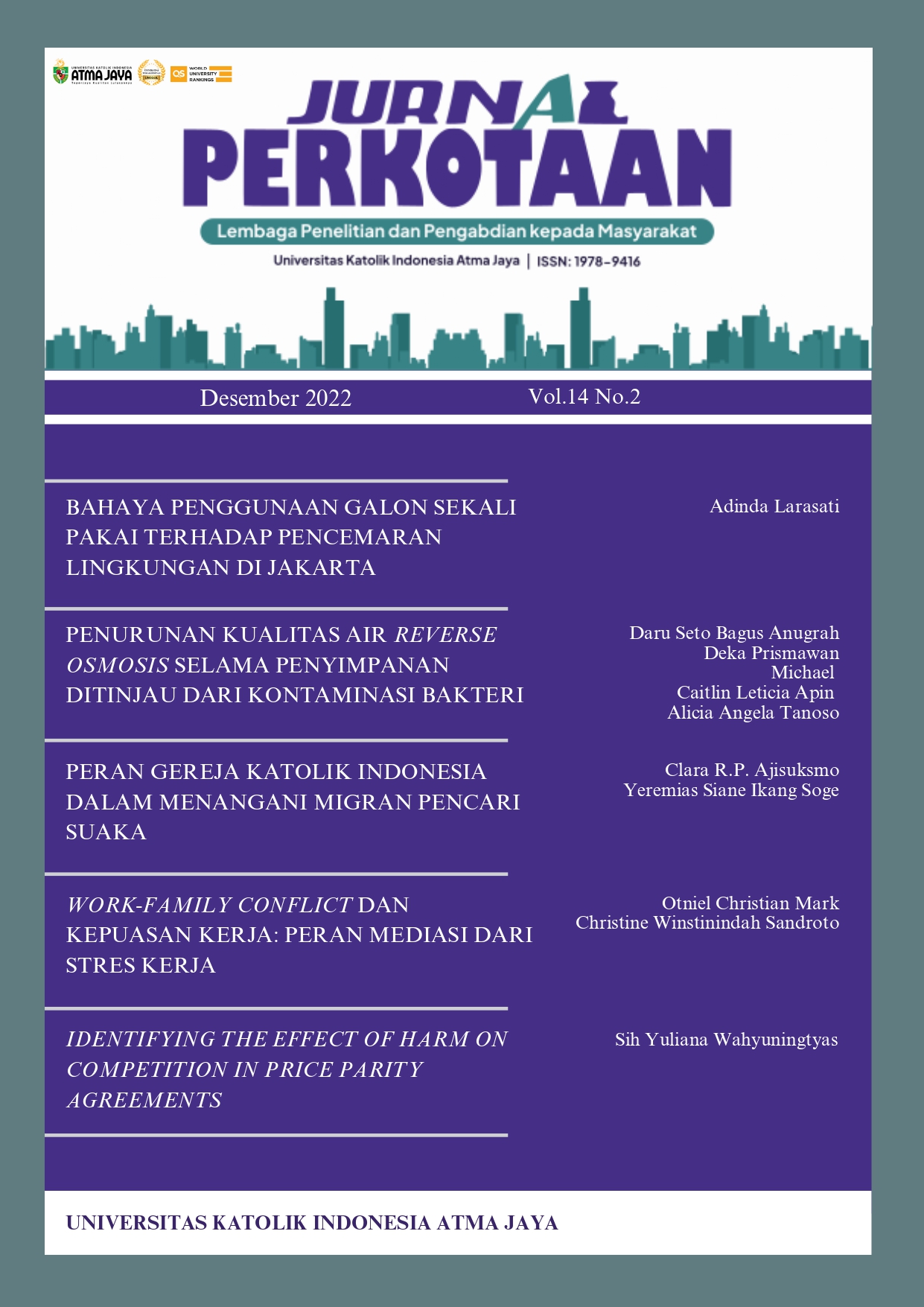Identifying the Effect of Harm on Competition in Price Parity Agreements
DOI:
https://doi.org/10.25170/perkotaan.v14i2.5669Keywords:
Price Parity Agreements, Harmful Effect, Competition, Rule of Reason, IllegalityAbstract
The paper aims to examine the harmful elements of price parity agreements by expounding showcases from Indonesia and Germany and discussing whether the rule of reason is the best approach to prohibit price parity agreements. The research is based on a normative legal study using legal comparison (Indonesia, Germany, and the European Union); the data is collected employing library research. The harmful elements of price parity agreements lie in limiting the freedom of suppliers to set prices and creating entry barriers for new players. The rule of reason approach to defining illegality is based on assessing the harmful effects of conduct, which implies that the respective conduct as such (per se) is not prohibited and becomes prohibited only when the second part of the clause is met. Further, although an effect assessment is required, the approach does not require an actual effect. A potential effect is sufficient for the prohibition. The originality of the paper is found in three aspects: first, the analysis of legal theories and regulations by challenging them with a different approach from the current approach for competition law assessment; second, drawing conceptual solutions to deal with the current problems; and third, providing scientific arguments to underpin the use of the application approach.
References
MO Mackenrodt, ‘Assessing the Effects of Intellectual Property Rights in Networks Standards’ in J Drexl, (Ed.), Research Handbook on Competition Law and Intellectual Property (Edward Elgar, Cheltenham 2008), p. 81-82.
KPPU Decision No. 02/KPPU-L/2005 - Carrefour, para. 9.1. ff, p. 87 ff.
Buehler, B., Coublucq, D., Hariton, C. et al. Recent Developments at DG Competition: 2016/2017. Rev Ind Organ (2017) 51, 411, https://doi.org/10.1007/s11151-017-9592-x
Mackenrodt, MO. Price and Condition Parity Clauses in Contracts Between Hotel Booking Platforms and Hotels. IIC (2019) 50, 1134-1135.
Beneke Avila, F.E. The German Federal Supreme Court’s Judgment in Booking.com as a Case Study of the Limitations of Competition Law. IIC (2022) 53, 1380-1381.
OLG Düsseldorf, 9 January 2015, VI-Kart 1/14 (V) – HRS.
Antitrust: Commission sends Statement of Objections to Google on comparison shopping service; opens separate formal investigation on Android [2015] IP 15/4780 (European Commission Press Release, 15 April 2015).
FCO Decision B2-98/11 – ASICS
AF Lubis/NN Sirait, (Ed.), Hukum Persaingan Usaha antara Teks dan Konteks (Deutsche Gesellschaft für Technische Zusammenarbeit, Jakarta 2009), p. 50; Säcker & Füller, in: Undang-undang Larangan Praktek Monopoli dan Persaingan Usaha Tidak Sehat Law Concerning Prohibition of Monopolistic Practices and Unfair Business Competition) (Katalis, Jakarta 2002), Art. 1 No.9 Margin No. 1; Article 2 I c UNCTAD Model Law; For practice in Europe, see Commission Notice on the definition of relevant market for the purposes of Community competition law (97/C 372/03), Introduction No. 2 <http://eur-lex.europa.eu/LexUriServ/LexUriServ.do?uri=CELEX:31997Y1209%2801%29:EN:NOT> accessed on 5 May 2010.
Law No. 5 of 1999 Art. 1 No.10; Lubis/Sirait, (Ed.) (n 5), p. 51.
Säcker & Füller (n 5), Art. 1 No. 10, Margin No. 22.
SY Wahyuningtyas, Unilateral Restraints in the Retail Business: A Comparative Study on Competition Law in Germany and Indonesia, Vol. 27 of Munich Series on European and International Antitrust law, 2011, p. 86.
Säcker & Füller (n 6), Article 1 No.10, Margin No. 9. See also the arguments in SY Wahyuningtyas (n 8), pp. 86 ff.
Säcker & Füller (n 6), Article 1 No.10, Margin No. 10. See also the arguments in SY Wahyuningtyas (n 8), pp. 86 ff.
Law No. 5 of 1999 Art. 1 no. 4.
Law No. 5 of 1999 Art. 25 par. (2).
Case T-201/04 Microsoft v Commission [2007] ECR II-3601, para 36.
Joined cases C-241/91P and C-242/91P Telefis Eireann and Independent Television Publications Ltd v. Commission of the European Communities (Magill) [1995] ECR I-743, para 53.
Joined cases C-241/91P and C-242/91P Magill (n 14), para 54.
Joined cases C-241/91P and C-242/91P Magill (n 14), para 55.
Joined cases C-241/91P and C-242/91P Magill (n 14), para 56. The cumulative exceptional circumstances were also applied in the IMS case and, more recently, in the European Microsoft case. Case C-418/01 IMS Health (n 18), para 38; Case T-201/04 Microsoft v Commission (n 14), para 333-3.
N Banasevic & P Hellström, ‘Windows into the World of Abuse of Dominance: An Analysis of the Commission’s 2004 Microsoft Decision and the CFI’s 2007 Judgement’, in L Rubini, (ed.), Microsoft on Trial: Legal and Economic Analysis of A Transatlantic Antitrust Case (Edward Elgar, Cheltenham 2010), 53-61.
KPPU Decision No. 02/KPPU-I/2004 – Telekom SLI. SLI stands for “Sambungan Langsung Internasional” (Direct International Connection)
This type of refusal to deal can also be seen in the case of ABC, see KPPU Decision No. 02/KPPU-I/2004 – Telekom SLI, KPPU Decision No. 06/KPPU-L/2004 – ABC.
Decision of Telkom Board of Directors, Keputusan Direksi Nomor: KD.39/HK220/Jas-51/2003 on 17 June 2003 concerning Guidelines for the Management of Telkom Outlet through Warung Telkom (KD Warung Telkom).
KPPU Decision No. 02/KPPU-I/2004 – Telekom SLI, para. 16.4.11.-16.4.12.
KPPU Decision No. 02/KPPU-I/2004 – Telekom SLI, para. 1.6.3.
KPPU Decision No. 02/KPPU-I/2004 – Telekom SLI, para. 7.5.
Consolidated Version of the Treaty on the Functioning of the European Union (2012) OJ C 326/47.
Commission Notice on the definition of the relevant market for Community competition law (1997) OJ C 372/5, para 7.
Case T-201/04 Microsoft v Commission (n 13).
Case T-201/04 Microsoft v Commission (n 13), para 36.
Case T-201/04 Microsoft v Commission (n 13), para 192-193.
Case T-201/04 Microsoft v Commission (n 13), para 662; P Samuelson and others, ‘Does Copyright Protection Under the EU Software Directive Extend to Computer Program Behaviour, Languages and Interfaces?’ (2012) 34(3) European Intellectual Property Law Review 158, 158; D Curley, ‘Interoperability and Other Issues at the IP-Antitrust Interface: The EU Microsoft Case’ (2008) 11(4) The Journal of World Intellectual Property 296, 311.
D Curley (n 30), para 783.
Commission (EC), ‘DG Comp Discussion Paper on the Application of Article 82 of the Treaty to Exclusionary Abuses’ (December 2005), para. 238 <http://ec.europa.eu/competition/antitrust/art82/discpaper2005.pdf> accessed on 20 March 2014.
S Anderman, ‘Does the Microsoft Case offer a New Paradigm for the ‘Exceptional Circumstances’ Test and Compulsory Copyright Licences under EC Competition Law?’ (2004) 1(2) The Competition Law Review 7, 9.
Steven Anderman formulates it as having a considerable degree of market power' as such that it 'virtually amounts to a de facto monopoly. See S Anderman, 'Does the Microsoft Case offer a New Paradigm for the ‘Exceptional Circumstances’ Test and Compulsory Copyright Licences under EC Competition Law?’ (2004) 1(2) The Competition Law Review 7, 9.
Steven Anderman formulates it as having a considerable degree of market power' as such that it 'virtually amounts to a de facto monopoly. See S Anderman, 'Does the Microsoft Case offer a New Paradigm for the ‘Exceptional Circumstances’ Test and Compulsory Copyright Licences under EC Competition Law?’ (2004) 1(2) The Competition Law Review 7, 9.
Joined cases C-241/91P and C-242/91P Magill (n 14), para 54.
Joined cases C-241/91P and C-242/91P Magill (n 14), para 55.
Joined cases C-241/91P and C-242/91P Magill (n 14), para 56, Case C-418/01 IMS Health (n 18), para 38; Case T-201/04 Microsoft (n 14), para 333-3.
N Banasevic & P Hellström, ‘Windows into the World of Abuse of Dominance: An Analysis of the Commission’s 2004 Microsoft Decision and the CFI’s 2007 Judgement’, in L Rubini, (ed.), Microsoft on Trial: Legal and Economic Analysis of A Transatlantic Antitrust Case (Edward Elgar, Cheltenham 2010), 53-61.
Case T-201/04 Microsoft (n 13), para 228; see also P Larouche, ‘The European Microsoft Case at the Crossroads of Competition Policy and Innovation’ (2008) 75 Antitrust Law Journal 601, 610.
Case T-201/04 Microsoft (n 13), para 353.
Case T-201/04 Microsoft (n 13), para 691.
EM Fox, ‘What Is Harm to Competition? Exclusionary Practices and Anticompetitive Effects’ (2002) 70 Antitrust Law Journal 372, 372.
KPPU Decision No. 02/KPPU-L/2005 – Illegal Trading Terms by Carrefour.
Joined cases C-241/91P and C-242/91P Magill (n 14); Case C-418/01 IMS Health (n 17); Case T-201/04 Microsoft (n 13).
UNCTAD, Exclusionary Anticompetitive Practices, Their Effects on Competition and Development, and Analytical and Remedial Mechanisms, UNCTAD/DITC/CLP/2005/4, p. 31.
Recent cases in the EU, for instance: Motorola Mobility [2014] IP/14/489 (European Commission Press Release, 29 April 2014); Samsung [2014] IP/14/490 (European Commission Press Release, 29 April 2014); Case C-170/3 – Huawei Technology Co. Ltd. v. ZTE Corp., ZTE Deutschland GmbH, 5 April 2013.
The second clause here refers to "monopolistic practices and or unfair (business) competition."
Article 1 No. 2 of Law No. 5/1999.
Siswanto, Hukum Persaingan Usaha (Ghalia, Jakarta 2004), p. 77.
Article 1 No. 6 of Law No. 5/1999.
Säcker & Füller (n 5), Article 1 No. 6 para. 8-9.
Säcker & Füller (n 5), Article 1 No. 6 para. 10.
Article 5 (1) of Law No. 5/1999.
Article 6 of Law No. 5/1999.
Article 15 of Law No. 5/1999.
Article 25 of Law No. 5/1999.
Article 26 of Law No. 5/1999.
Säcker & Füller (n 5), Article 1 No. 6 para. 12.
OECD, 2015, OECD Executive Summary of the Hearing on Across-Platforms Parity Agreement
https://one.oecd.org/document/DAF/COMP/M(2015)2/ANN3/FINAL/en/pdf.










